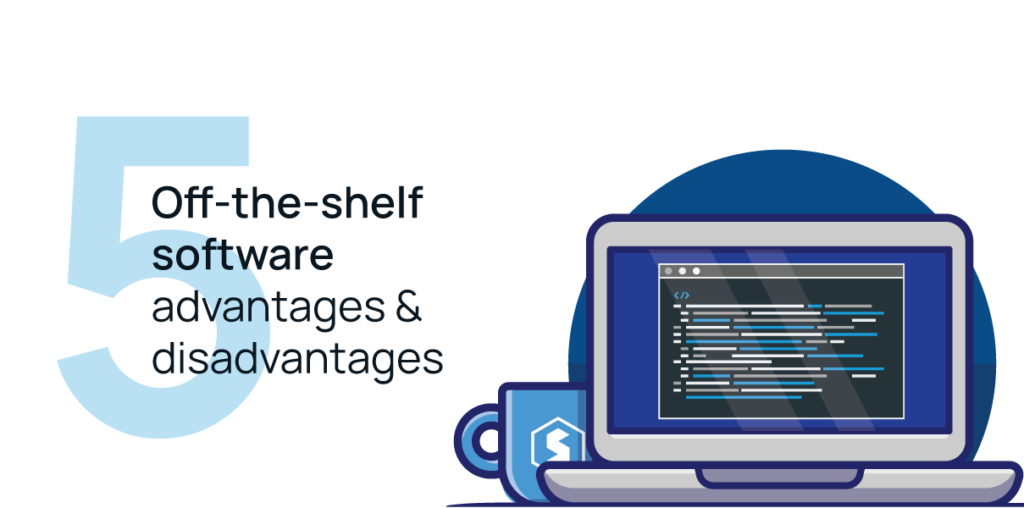5 Off-The-Shelf Software Advantages and Disadvantages
Off-the-shelf software products are generic software solutions that developers release for immediate use for the mass market.
Unlike custom software, which is tailor-fit to meet the requirements of a specific user (and can give you a competitive advantage), off-the-shelf software packages simply come with a standardized set of features created for a wide range of customers.
But, if you’re considering customer software vs off-the-shelf software, is off-the-shelf software right for your business?
The following advantages and disadvantages of off-the-shelf software solutions can help you decide:
Off-the-shelf software advantages and disadvantages for your business
When it comes to looking at off-the-shelf application software advantages and disadvantages, weigh them all first before deciding how to move forward with your next project.
1. Cost
Most business owners believe that one of the greatest advantages of using off-the-shelf software is that it’s the cheaper option compared to custom software development. However, this isn’t always the case.
It’s more accurate to say that off-the-shelf software is cheaper in terms of its upfront investment — it’s cheaper to buy generic software than to commission custom-built software designed to address your specific needs.
However, off-the-shelf software can actually be more expensive for your business in the long run, due to additional costs like ongoing licensing fees, the costs associated with additional users, the cost of new versions, and any custom development or integrations you need.
Therefore, depending on how long you intend to use the software and how many users will need to access it, an off-the-shelf solution can become more expensive than building custom software.
Ultimately, it’s important to consider not only the upfront costs but the lifetime costs of the software.
Ho to find the best software solution for your business? Check out these articles:
2. Flexibility
Pre-existing software generally offers the immediacy of use (as it’s developed for the mass market) with a significant number of features. After a quick setup and implementation process, your business can be up and running with off-the-shelf software.
With bespoke software, on the other hand, you’ll need to identify your requirements, work with a development team and wait for the team to finish building your new tool.
However, these benefits come with a massive disadvantage—off-the-shelf software isn’t usually very flexible, which can make it difficult to adapt the tool to your needs.
Vendors may be able to make small changes, and you may be able to add functionality through APIs and integrations, but individual users may still struggle to map their existing workflows to the new software.
That said, even creating hybrid software versions that introduce the features you require through integrations can be costly (if it’s even possible in the first place).
In the long run, using off-the-shelf software can leave you facing a number of flexibility issues, as well as the risk that your software will become outdated if updates invalidate the customizations you’ve made.
3. Control
Although off-the-shelf software is easy to implement and you can try it before you buy, your business has effectively zero control over the product or the source code. You have no input into or power over the changes that will be made, whether they affect your business for better or worse.
For instance, imagine that a new update to your off-the-shelf software removes or reworks a feature you formerly depended on. Since you have no control over the choices made by the software’s vendor, you may find that the system no longer suits your business.
4. Support
Not all off-the-shelf software comes with customer service support.
Usually, the kind of support you get depends on what kind of license you have or how much you’re paying. In other cases, when versions of the software become outdated, support may stop altogether.
If you go the off-the-shelf route, make sure you investigate the kind of support that will be available for the kind of license you plan to purchase. Ideally, one that professes to build the customer relationship past the point of initial purchase. Extrapolate that out a few years for the long term, and plan for how you’ll handle any issues that arise if you no longer have access to the vendor’s support.
5. Upgrades
When comparing the advantages and disadvantages of application packages of off-the-shelf software (or pros and cons), you should be aware if it’s available in different versions, and if each comes with a different price tag.
One version may be more expensive than the other, depending on the features and type of support included. Moreover, later upgrades can come with features you need — but they may come at a cost. This is especially true if you’ve modified your software or introduced integrations that will also need to be updated.

Off-The-Shelf Software: Yes or No?
Comparing the advantages and disadvantages of bespoke and off-the-shelf software should help you decide whether it’s right for your business or whether custom software development is the way to go.
As you make your decision, make sure all of your requirements have been clearly captured and written down. Understanding what you’re hoping to achieve with software will help you identify the best course for fulfilling your needs while minimizing costs.
